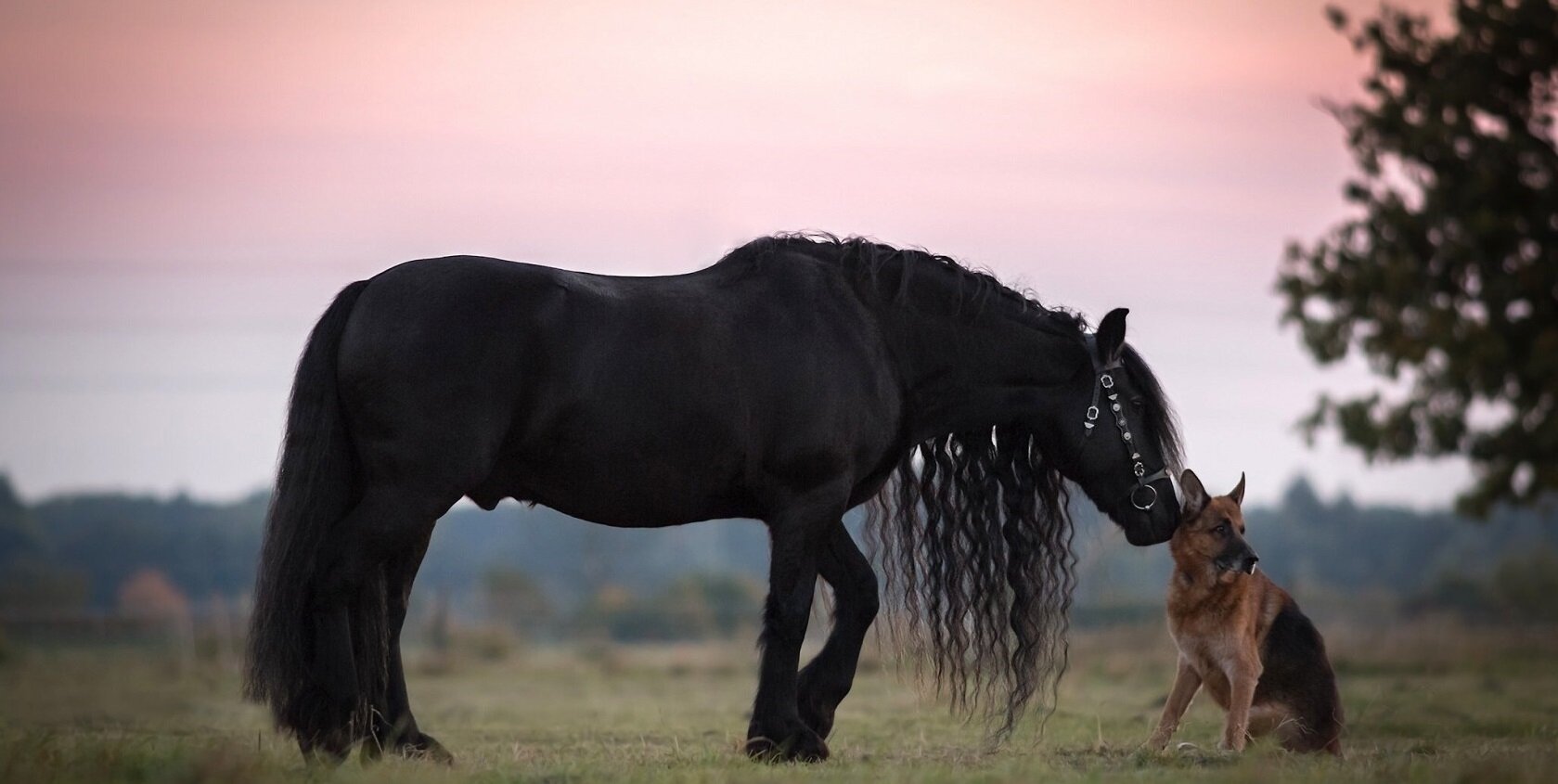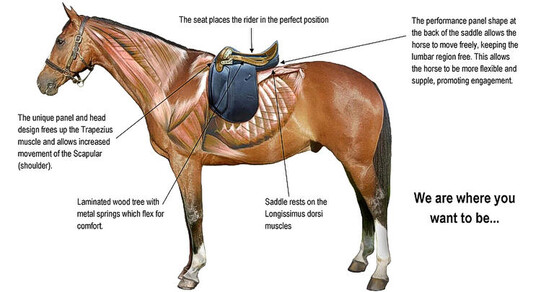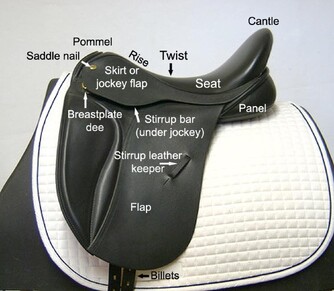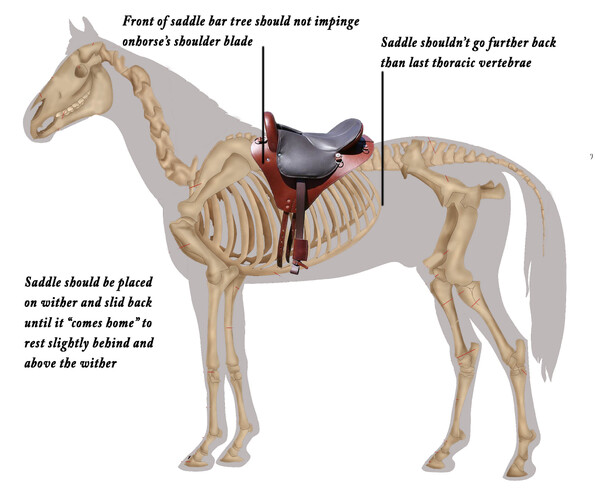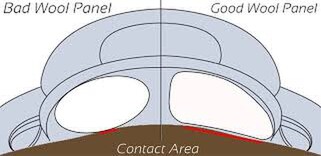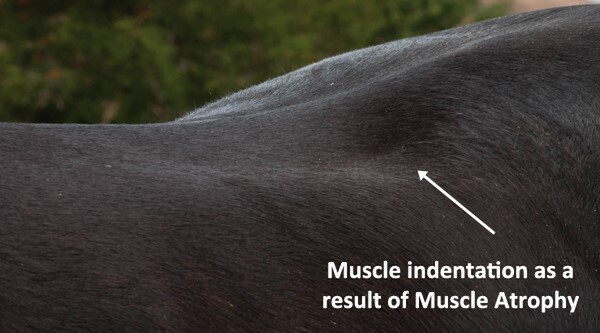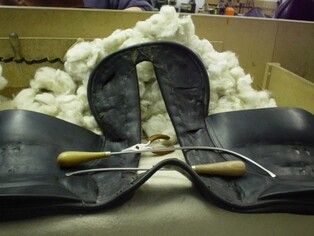Saddle fit Issues
As a therapist I do continually deal with saddle fit issues. To tackle this issue I have also just started studying to become an Accredited Saddle fitter as there are many inconsistencies in saddle fit for both horses and riders. Many of my clients as myself are never sure the type of flock used and what saddles are better used for different horse body types.
Where one brand of saddle may have worked for someone else may not work on your horse. Thus, I figured the more people of aware of saddles the more we can help our equine partners.
The horse has nothing to say regarding what we impose on its back, so it is a mark of respect to look for a saddle that will not pinch, rub or injure it
Adjusting flocking is the saddle fit version of fine-tuning. It is not changing the overall fit of the saddle.
Adjusting the flocking when the tree is the wrong shape would not fix the problem. It's like adding an extra hole to your belt in an attempt to make a pair of jeans fit.
Adjusting the flocking only works when the tree is already a fundamentally good fit. The same goes for any flocking substitute, such as risers or wedges inserted into the panels. It is not enough to make a saddle fit the horse, when the tree is the wrong shape.
Where one brand of saddle may have worked for someone else may not work on your horse. Thus, I figured the more people of aware of saddles the more we can help our equine partners.
The horse has nothing to say regarding what we impose on its back, so it is a mark of respect to look for a saddle that will not pinch, rub or injure it
Adjusting flocking is the saddle fit version of fine-tuning. It is not changing the overall fit of the saddle.
Adjusting the flocking when the tree is the wrong shape would not fix the problem. It's like adding an extra hole to your belt in an attempt to make a pair of jeans fit.
Adjusting the flocking only works when the tree is already a fundamentally good fit. The same goes for any flocking substitute, such as risers or wedges inserted into the panels. It is not enough to make a saddle fit the horse, when the tree is the wrong shape.
Many Horses have high withers, middling withers and rangy tabletops. High withers can extend way back into the area of the saddle. Looking along the spine, we can see dippy backs, straight backs and bumpy backs.
This is before we even look at damaged backs, uneven shoulders, laterally curved spines, and all manner of physical issues affecting the horse, rider and the saddle in between.
Horses have a combination of these features. Many horses have one or two that can make saddle fitting a bit tricky. Some have combinations that make saddle fitting an utter nightmare.
The saddle's tree must reflect all those variations. It's what makes saddle fitting such an interesting challenge, and occasionally a very hard one.
The Comfort Connection
Whatever the panels are constructed of, they must, first and foremost, be comfortable. The ideal panel is soft (not too soft) and supple, and elastic enough to absorb shock while being breathable. Since our horses are athletes, their comfort is essential to enhance performance and prevent breakdown. If you were asked to run a mile in uncomfortable shoes, you'd find that your entire body hurts – it's not just about blisters on your heels.
Panels that are hard and lumpy don't just cause back pain, they can actually bruise the muscles, and in severe cases, a horse requires months off before being able to be worked again.
This is before we even look at damaged backs, uneven shoulders, laterally curved spines, and all manner of physical issues affecting the horse, rider and the saddle in between.
Horses have a combination of these features. Many horses have one or two that can make saddle fitting a bit tricky. Some have combinations that make saddle fitting an utter nightmare.
The saddle's tree must reflect all those variations. It's what makes saddle fitting such an interesting challenge, and occasionally a very hard one.
The Comfort Connection
Whatever the panels are constructed of, they must, first and foremost, be comfortable. The ideal panel is soft (not too soft) and supple, and elastic enough to absorb shock while being breathable. Since our horses are athletes, their comfort is essential to enhance performance and prevent breakdown. If you were asked to run a mile in uncomfortable shoes, you'd find that your entire body hurts – it's not just about blisters on your heels.
Panels that are hard and lumpy don't just cause back pain, they can actually bruise the muscles, and in severe cases, a horse requires months off before being able to be worked again.
Depending on how your horse's back slopes down from the spine on either side, you will want to consider the shape of the panels from side to side in hopes they are similar angles.
Horses are constantly changing shape
Also, the tree shape vs your horse's profile can seriously impact flocking. If your horse is curvy backed and your saddle has a flat tree/panel profile you will have to reflock a lot more than if you have a saddle tree that matches your horses back profile. Flocking naturally congregates to follow the tree profile.
Complete reflocks cannot be done in a day. Why not? Because the flocking needs to settle for at least 24 hours as, even the most experienced saddlers have found, sometimes wool will settle and create holes. We prefer that the wool settles at our place for easy correction than you discovering the problem and being disappointed.
Fitting the wither: The gullet
(or front of the channel under the tree points)
The gullet, which sits over the wither, must be of an angle and width and shape that compliments the wither. The gullet shape is dictated by the angle and width of the tree points and the thickness and shape of the padding overlying them. Saddles that are too narrow in the gullet are one of the most common causes of back pain. (Second only to saddles that are fitted too far forward).
Ideally most horses should have their saddle checked every three months or so in case adjustments need to be made to compensate for changes in wither shape with the changes in fat and muscle cover that occur as diet and exercise programs change.
Adjustable gullet systems. Adjustable gullet systems are usually necessary for maintaining good saddle fit. Several such systems are now available. Ainsley, Bates, Kieffer and Laser all have saddles with adjustable gullet systems. The Bates "Easy change gullet system", Ainsley adjustable head system and the Laser "InfiniTree" system.
Panel
Panel softness and ability to absorb concussion. Different fillings are available. Air Panels can be comfortable if fitted properly. These are able to conform to the changes in the horse's top line shape, as it moves and changes posture. There are known as FLAIR or CAIR system which are nice and soft and comfortable, and yet are not so thick as to cause excessive motion between the rider and the horse.
The Flair system (Wow Saddles) can be fitted to most saddles and requires inflation by a trained fitter, with the saddle on the horse and rider in the saddle. A simplified air bag system (CAIR – Bates/Wintec) has been developed and offers very good comfort for the horse. The CAIR system does not require special inflation and is suited to a wide range of horses and riders. They do require adding shims to allow for change in shape. Ideally to be done by saddle fitter and not owner.
Next to the air panels, the best, commonly used filling or flocking is synthetic wool. Often some of this white woolly material is seen protruding from the underside of the panels. If not over packed it offers good comfort for the horse where the panel surface area is adequate. This type of flocking can be adjusted by your saddler to suit the shape of you horse and also tends to move a little to conform better to the horse's back.
Broad, flat panelled, gel-foam fitted panels can also be comfortable for horses, but in general, foam or felt filled panels are less comfortable than wool or air filled panels. Regular foam or felt filled panels suit a small number of horses well but in many instances are associated with back soreness.
Often the angle of the foam panels is not suited to the horse's back and as a result pressure points are commonly created towards the outside of the saddle seat. Felt and foam panels are difficult or impractical to adjust and thus are a problem if the horse changes shape with muscle cover, fat cover or age.
Horses are constantly changing shape
- especially if growing, have been injured or coming into work
- All good saddle fitters should take this into account when assessing your horse.
Also, the tree shape vs your horse's profile can seriously impact flocking. If your horse is curvy backed and your saddle has a flat tree/panel profile you will have to reflock a lot more than if you have a saddle tree that matches your horses back profile. Flocking naturally congregates to follow the tree profile.
Complete reflocks cannot be done in a day. Why not? Because the flocking needs to settle for at least 24 hours as, even the most experienced saddlers have found, sometimes wool will settle and create holes. We prefer that the wool settles at our place for easy correction than you discovering the problem and being disappointed.
Fitting the wither: The gullet
(or front of the channel under the tree points)
The gullet, which sits over the wither, must be of an angle and width and shape that compliments the wither. The gullet shape is dictated by the angle and width of the tree points and the thickness and shape of the padding overlying them. Saddles that are too narrow in the gullet are one of the most common causes of back pain. (Second only to saddles that are fitted too far forward).
Ideally most horses should have their saddle checked every three months or so in case adjustments need to be made to compensate for changes in wither shape with the changes in fat and muscle cover that occur as diet and exercise programs change.
Adjustable gullet systems. Adjustable gullet systems are usually necessary for maintaining good saddle fit. Several such systems are now available. Ainsley, Bates, Kieffer and Laser all have saddles with adjustable gullet systems. The Bates "Easy change gullet system", Ainsley adjustable head system and the Laser "InfiniTree" system.
Panel
Panel softness and ability to absorb concussion. Different fillings are available. Air Panels can be comfortable if fitted properly. These are able to conform to the changes in the horse's top line shape, as it moves and changes posture. There are known as FLAIR or CAIR system which are nice and soft and comfortable, and yet are not so thick as to cause excessive motion between the rider and the horse.
The Flair system (Wow Saddles) can be fitted to most saddles and requires inflation by a trained fitter, with the saddle on the horse and rider in the saddle. A simplified air bag system (CAIR – Bates/Wintec) has been developed and offers very good comfort for the horse. The CAIR system does not require special inflation and is suited to a wide range of horses and riders. They do require adding shims to allow for change in shape. Ideally to be done by saddle fitter and not owner.
Next to the air panels, the best, commonly used filling or flocking is synthetic wool. Often some of this white woolly material is seen protruding from the underside of the panels. If not over packed it offers good comfort for the horse where the panel surface area is adequate. This type of flocking can be adjusted by your saddler to suit the shape of you horse and also tends to move a little to conform better to the horse's back.
Broad, flat panelled, gel-foam fitted panels can also be comfortable for horses, but in general, foam or felt filled panels are less comfortable than wool or air filled panels. Regular foam or felt filled panels suit a small number of horses well but in many instances are associated with back soreness.
Often the angle of the foam panels is not suited to the horse's back and as a result pressure points are commonly created towards the outside of the saddle seat. Felt and foam panels are difficult or impractical to adjust and thus are a problem if the horse changes shape with muscle cover, fat cover or age.
Panel surface area
Broad panels distribute the weight of the saddle over a greater surface area. This reduces the pressure under the saddle and reduced pressure simply means less damage to the horses back. It's just like the difference between the pressure under high heeled shoes as compared to that of flat heeled shoes.
Panel shape. The panels of the seat area should conform to the shape of the horse's back. In most cases a reasonably flat panel will be appropriate as this is the shape of the top of the rib cage that is the underlying support for the saddle.
Girth points
The importance of girth point placement is very often overlooked. Inappropriate girth point placement can cause the saddle to continually move forward or back. Adjustable Y systems or similar, with the most forward girth point coming off the tree point of the saddle, are recommended. The points should then be adjusted according to the chest shape of horse. Most have a girth notch into which the girth tends to lie.
Broad panels distribute the weight of the saddle over a greater surface area. This reduces the pressure under the saddle and reduced pressure simply means less damage to the horses back. It's just like the difference between the pressure under high heeled shoes as compared to that of flat heeled shoes.
Panel shape. The panels of the seat area should conform to the shape of the horse's back. In most cases a reasonably flat panel will be appropriate as this is the shape of the top of the rib cage that is the underlying support for the saddle.
Girth points
The importance of girth point placement is very often overlooked. Inappropriate girth point placement can cause the saddle to continually move forward or back. Adjustable Y systems or similar, with the most forward girth point coming off the tree point of the saddle, are recommended. The points should then be adjusted according to the chest shape of horse. Most have a girth notch into which the girth tends to lie.
Muscle atrophy (indentations) underneath or just behind the saddle panel.
If the horse's back is showing visual indentations under the panel wedge, this is a clear sign that either the saddle is too long or there is too much pressure on the loins because of the wedge itself.
The horse must be able to move freely under saddle; a saddle that has been fit correctly to the moving horse. The saddle should never make the rider feel like he is glued to the horse's back, nor should the saddle be fit exactly to the static back, so that the rider can actually ride the horse in suspension, in motion.
The trainer teaches the rider to sit the horse lightly and freely. The saddle fitter needs to fit the saddle to the horse so that the horse and the saddle both adapt themselves to the movement of the rider
The question is whether you want to have engaged, supple harmonious riding due to a properly fitted saddle, or if you prefer to have a saddle that looks like it fits absolutely perfectly – when the horse is standing still in the crossties. The saddle should be fitted with rider up and asses whether the rider suits the saddle as well and how the saddle fits in motion. If Saddle doesn't fit in motion then further adjustments should be made so as to not result in discomfort, and potentially long term damage.
A correctly fitting saddle should need no saddle pad – their function is to protect the panel leather from the sweat of your horse, but too often they are used as Band-Aid's to help out where the saddle doesn't fit
The panel should always be thoroughly inspected to make sure it is smooth and even. Often when a saddle has not been reflocked in a long time the panel needs to be completely removed and the wool mix properly distributed or changed. Though not always necessary, when restuffing is done without removing the panel, the correct saddler tools and same flock as in the saddle should be used to prevent damage to the leather itself.
When a rider has a behavior or a training problem, a succession of bad performances, they rarely think of the saddle. The rider would rather think they have a bad horse, a bit that is not strong enough, or a coach who is not good enough. However the rider does not know, or think, that all those issues can be caused by an ill-fitting saddle.
A horse that bucks when cantering can buck because his loins are crushed by the saddle. A horse that does not stay on the bit and hollows his back when bending might do so because the gullet of the saddle is so narrow that the spine cannot correctly bend. It is not a real training issue, but maybe we prefer to force the bend and the attitude and risk back soreness. If we don't think of the way the saddle fits the horse, come to an end where the saddle causes severe injuries to the back.
If the horse's back is showing visual indentations under the panel wedge, this is a clear sign that either the saddle is too long or there is too much pressure on the loins because of the wedge itself.
The horse must be able to move freely under saddle; a saddle that has been fit correctly to the moving horse. The saddle should never make the rider feel like he is glued to the horse's back, nor should the saddle be fit exactly to the static back, so that the rider can actually ride the horse in suspension, in motion.
The trainer teaches the rider to sit the horse lightly and freely. The saddle fitter needs to fit the saddle to the horse so that the horse and the saddle both adapt themselves to the movement of the rider
The question is whether you want to have engaged, supple harmonious riding due to a properly fitted saddle, or if you prefer to have a saddle that looks like it fits absolutely perfectly – when the horse is standing still in the crossties. The saddle should be fitted with rider up and asses whether the rider suits the saddle as well and how the saddle fits in motion. If Saddle doesn't fit in motion then further adjustments should be made so as to not result in discomfort, and potentially long term damage.
A correctly fitting saddle should need no saddle pad – their function is to protect the panel leather from the sweat of your horse, but too often they are used as Band-Aid's to help out where the saddle doesn't fit
The panel should always be thoroughly inspected to make sure it is smooth and even. Often when a saddle has not been reflocked in a long time the panel needs to be completely removed and the wool mix properly distributed or changed. Though not always necessary, when restuffing is done without removing the panel, the correct saddler tools and same flock as in the saddle should be used to prevent damage to the leather itself.
When a rider has a behavior or a training problem, a succession of bad performances, they rarely think of the saddle. The rider would rather think they have a bad horse, a bit that is not strong enough, or a coach who is not good enough. However the rider does not know, or think, that all those issues can be caused by an ill-fitting saddle.
A horse that bucks when cantering can buck because his loins are crushed by the saddle. A horse that does not stay on the bit and hollows his back when bending might do so because the gullet of the saddle is so narrow that the spine cannot correctly bend. It is not a real training issue, but maybe we prefer to force the bend and the attitude and risk back soreness. If we don't think of the way the saddle fits the horse, come to an end where the saddle causes severe injuries to the back.
Why start with selecting a saddle that is comfortable for your horse rather than yourself? If the horse is not comfortable then ultimately it's behavior will deteriorate to the point that you will never get a good ride anyway. The rider is more likely to accommodate to a saddle that is not completely ideal for the rider than the horse is to a badly fitting saddle. Ultimately, however, both the comfort of the rider and the horse are very important.
Comfort for the horse is dictated by the placement of the saddle, the saddle fit with respect to the withers and shape of the spine, the comfort of the panels, the length of the saddle and closeness of the saddle to the horse (and of course, the way that the person rides).
Horses change shape: as they move, with the amount of fat cover, with their degree of fitness and muscle development, with pregnancy, with muscular problems of the spine, and with age. Saddles need to be such that they can be adjusted to accommodate for these changes.
Before any saddle is fitted you should have your horse's spine checked and treated so call Nash now to discuss any issues with your horses back.
Comfort for the horse is dictated by the placement of the saddle, the saddle fit with respect to the withers and shape of the spine, the comfort of the panels, the length of the saddle and closeness of the saddle to the horse (and of course, the way that the person rides).
Horses change shape: as they move, with the amount of fat cover, with their degree of fitness and muscle development, with pregnancy, with muscular problems of the spine, and with age. Saddles need to be such that they can be adjusted to accommodate for these changes.
Before any saddle is fitted you should have your horse's spine checked and treated so call Nash now to discuss any issues with your horses back.
